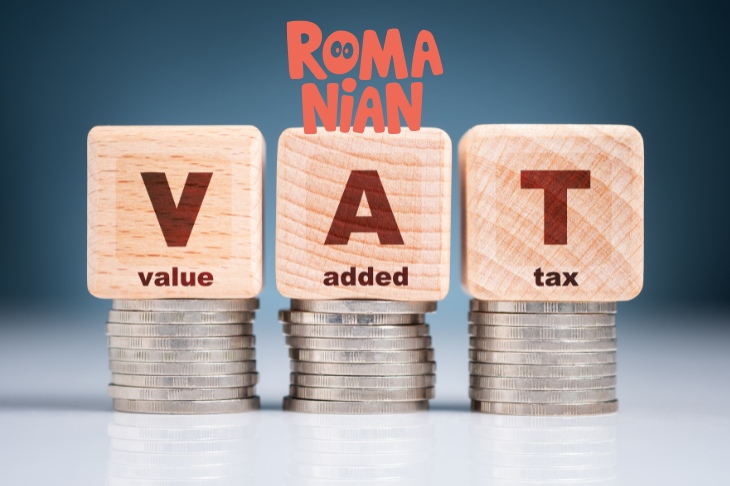

Romanian VAT is one of the tax topics that very often generate much confusion, frustration, but also interest from business owners or financial specialists. You may be an entrepreneur in Romania setting up your first company, a freelancer invoicing clients across borders, or a foreign investor expanding your operations into Romania. For your business is very important that you understand how Romanian VAT works.
While the concept of VAT (Value Added Tax) is harmonized across the European Union, each member state has its own particularities. In this article we explain how Romanian VAT works in practice, what changes were introduced in 2025, and how to stay compliant without turning your tax reporting into a daily headache. This is Romanian VAT explained – clearly, practically, and with just enough humour to make taxes almost enjoyable.
VAT, or “Taxa pe Valoarea Adăugată” (TVA) in Romanian, is a consumption tax charged at each stage of the supply chain but ultimately borne by the final consumer. It’s one of the most important revenue sources for the Romanian government, representing over 30% of the total tax income.
In simple terms, every time a business sells goods or services, it adds VAT to their price, collects it from the customer, and later remits it to the tax authorities. At the same time, it can deduct the VAT it pays on its own purchases. The difference between the VAT collected and the VAT paid is the amount owed (or refundable) to the state.
For example, if your company sells a consulting service worth 10,000 RON plus VAT, your client pays you 10,000 plus VAT. Out of this, the VAT portion you collected (generally called output VAT) is remitted to the state after deducting input VAT (VAT paid on allowed business expenses).
This mechanism ensures VAT is applied only on the “added value” at each stage of production or service delivery. It’s simple in theory, but in practice applying VAT correctly requires navigating registration thresholds, exemptions conditions, reverse charges, and compliance procedures.
Not every business operating in Romania is automatically subject to VAT. Registration for VAT depends on turnover thresholds, business activities, and whether you’re business is based in Romania or abroad.
In 2025, under the new rules, the VAT registration threshold for all enterprises was increased to RON 395,000 (from the prior RON 300,000 threshold). This change came into effect as of 1 September 2025.
Foreign companies providing taxable goods or services in Romania – even without a permanent establishment – may still need to register, depending on place of supply rules, reverse charge applicability, or whether they sell to consumers (non-VAT registered entities). That part of the regime hasn’t changed in principle, though the VAT rate you would charge post-August is different (we explain further below the new VAT rates).
For Romanian freelancers (PFA) and other micro-businesses, the same threshold logic applies: if their turnover goes beyond RON 395,000 (post-September), registration becomes mandatory. Below this threshold exemption remains possible (or one may choose voluntary registration for input VAT recovery).
Romania introduced one of its most significant VAT changes starting 1 August 2025. Through Law no. 141/2025, effective that date, the standard rate was increased and reduced rates were consolidated.
Here’s how it works now:
The 11% rate now covers supplies that previously fell under 5% or 9%, such as:
However, some previously reduced-rate items have shifted to 21%. For example:
That transitional rule for housing is a particularly tricky area: if a contract was in place before 1 August 2025 and an advance payment made (or other legal conditions met), the old 9% rate may still apply until 31 July 2026.
The exemption regime remains structurally similar: some operations are exempt (with or without deduction), while exports and intra-community supplies are zero-rated (i.e., exempt with deduction). The mid-year rate changes didn’t fundamentally alter the list of VAT exemptions, but having fewer rates now leaves less room for confusion.
The exemption without deduction still covers items like:
The exemption with deduction or zero-rate applies to:
For these, you don’t charge VAT to the customer, but you can still deduct input VAT. The documentation rules to validate zero-rating remain strict (proof of transport, invoices, dispatch evidence, etc.).
It’s important to know that, for many of the goods and services which are now under the 11%, the reduced rate can be applied only if conditions are met. Failure to qualify pushes the service to the standard rate of 21%. So, in practice the scope of exemptions has become narrower, because there are now fewer VAT rate categories.
The registration procedure remains largely the same, but the trigger thresholds have changed (as explained above). Business entities (companies or freelancers) must submit the registration application to ANAF using the appropriate form (e.g. Form 010 or Form 070 for individuals). ANAF may request supporting documents: proof of address, company registration certificate, identification of shareholders or administrators, expected turnover, and description of economic activities.
Once approved, the company receives a VAT code prefixed with “RO” (e.g. RO12345678), which must appear on all invoices and VAT documents.
Foreign companies register either through a fiscal representative (if established outside the EU) or via the regional ANAF office for non-resident taxpayers (for EU entities). The process still typically takes around 10 working days, though ANAF may ask further clarifications.
The registration rules for distance selling, intra-community acquisitions, and cross-border services remain in place, including thresholds and identification regimes for non-resident taxable persons.
Most VAT-registered taxpayers must file returns monthly (Form 300). Under the old rules, smaller businesses could opt for quarterly VAT reporting if their turnover was modest. This option is still present depending on turnover and nature of activities, though thresholds and eligibility may adapt under guidance from ANAF.
VAT returns and payments are due by the 25th day of the month following the reporting period. So, VAT for August operations must be reported and paid by 25 September, for example.
Other statements that must be submitted are:
Because Romania now uses e-invoicing (“E-Factura” system) for all transactions, ANAF cross-checks invoice data, return data, and form statements. Any mismatch in rate coding (21% vs 11%) or misclassifications may trigger queries or audits.
For late filing or payment of VAT your business may still be subject to penalties and interest. In the context of 2025’s rate change, errors in rate application will draw additional scrutiny.
In Romania, the main principle that applies is the following: input VAT paid on eligible purchases for taxable operations is deductible against your output VAT liability. The shift in rates (21% vs 11%) means your tax codes must distinguish between which inputs correspond to 11%-rated supplies and which to 21%. Misallocation can lead to partial disallowance.
Refunds must be processed via the VAT return (Form 300) when deductible VAT exceeds output VAT. With the move to higher rates, the absolute amounts of refunds are larger, making the documentation and compliance more rigorous and more important.
For foreign (non-Romanian established) businesses, refunds can be requested under the EU VAT refund Directive (if they are EU businesses) or via reciprocity procedures (for non-EU ones). The mechanics remain, but the increased rates may incentivize claiming refunds for substantial input VAT incurred in Romania.
Reverse charge is and remains an essential piece of the VAT regime. In cross-border B2B services where place of supply rule falls to the recipient, the Romanian customer self-accounts for VAT (charging output and claiming input) – thus neutralizing cash flow impact. That continues unchanged in principle, although the rates (21% or 11%) now differ.
Domestically, the reverse charge mechanism continues to apply in Romania for specific sectors, such as trade in ferrous and non-ferrous metals, construction and demolition services, green certificates, and specific agricultural products.
Under this system, the responsibility to declare and pay the VAT shifts from the supplier to the customer. In other words, the supplier issues the invoice without charging VAT, and the customer – if registered for VAT in Romania – records both the output and input VAT in its own return. This way, the transaction remains VAT-neutral from a cash flow perspective. In the same time it reduces the risk of fraud that can occur when suppliers collect VAT and disappear before remitting it to the tax authorities.
This logic – determining whether a supply falls under reverse charge – hasn’t changed in 2025. What did become simpler is the rate mapping: all such operations are now either subject to the standard 21% or the reduced 11% rate, depending on the nature of the goods or services. Nevertheless, it remains important to check your contracts and the ANAF list of activities covered by reverse charge to ensure invoices are issued correctly.
So, if a transaction is within reverse charge scope, the supplier issues an invoice without VAT, and the customer records the VAT in its return.
Romania’s digitization push continues. The E-Factura system is now mandatory for all B2B and B2C VAT-registered transactions, meaning invoices must be issued via the government portal or integrated ERP. This mandate was already in place before the rate change, but in 2025 it becomes absolutely non-negotiable, because mis-rate coding errors are instantly visible.
On top of that, the rollout of e-Transport, the SAF-T, and improved real-time data analytics by ANAF means the tax authority can reconcile supply chains, transport records, and invoice data more tightly.
Given the 2025 VAT rate changes, it’s more important than ever that your systems – item master, tax categories, contract terms, etc. – align with legal definitions so that mistakes don’t cascade into compliance failures.
Do you have any experience with Romanian VAT compliance that you can share with our community or readers? Please post your useful advice in the comment box below.